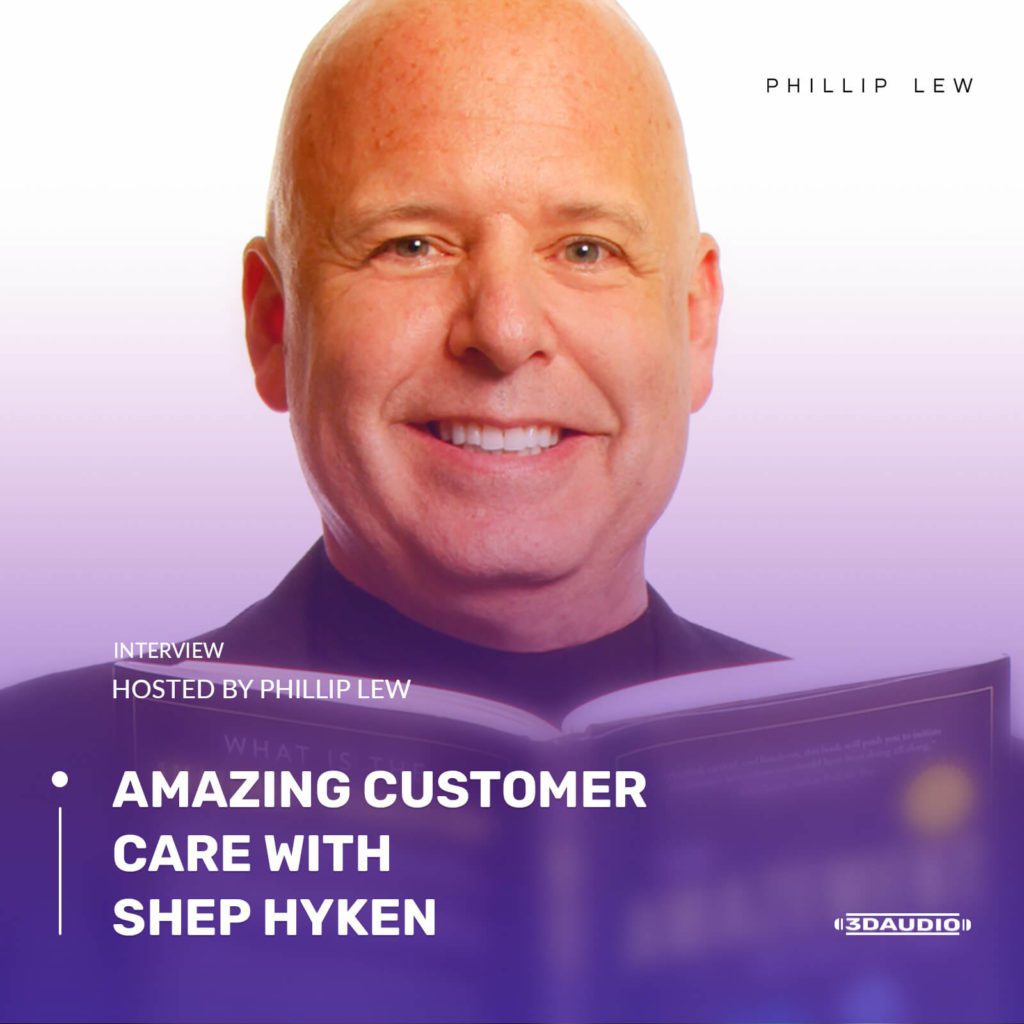
00:00
Paused.
Book Phillip to speak at your next event!
Amazing Customer Care with Shep Hyken
PHILLIP
So why, at the end of the day, when we look at the reality of customer service, that so few companies get it right? Why do organizations so often think that they have world-class customer care, only to get contradicted by their own customers online? A study by Forrester pointed out that 70% of companies think that their customer service should be graded a letter A, where only 11% of customers believe that companies actually deserve that letter A. So what’s the disconnect? What’s really going on here?
To investigate this topic, I decided to invite Shep Hyken, a famous motivational speaker, author and expert, to help shed some light on what’s really going on. I was quite nervous interviewing Shep Hyken. Considered a legend by many, I knew his insights would be deep and profound, and would help uncover this mystery in stunning detail and care. Within minutes of the segment, I immediately discovered that, for Shep, the concept of service was at the cornerstone of what most companies get wrong.
SHEP
But here’s the point of that comment is, really, do they come back, the only stat that matters? Well, in a sense, all the stats that you get, are they happy with us? Would they be willing to recommend us, etc., etc., I think those are powerful statistics. They tell a story. They tell that your customers…they confirm to you that your customers are happy with what you do. Really, I think the next level of that is, “Hey, I don’t care how happy they are, are they coming back?” So, that’s where it comes from. So, benefits of great service.
And, by the way, you said an awful lot in that opening monologue and number one is service is no longer the after-experience, what happens after you, you know, make a purchase, no. Service is happening throughout the entire process, throughout the entire experience. It could be just the way a salesperson promptly responds to your first inquiry. I mean, you haven’t bought anything and you may not buy anything till after that salesperson meets with you three times. But if that salesperson, along the way…and I’m just using sales as an example. It could be anything, okay? But if that salesperson, along the way, proves to you that they show up on time, they call you back, they get you what they promised when having to get your proposal, it shows up when it’s supposed to show up, etc., etc., you start to develop this confidence.
And the confidence is, not only in that person, but if you really think about it, the confidence is the experience to that person, and therefore, that company is providing is predictable, it’s consistent. And so, to be amazing, you can’t just be, you know, like, “Hey, let’s just give them good service,” because people fall between average and good and maybe a little less, and sometimes, it spikes to over the top. But when your customers are saying, you know, “I love doing business with them because they’re always fast to respond. They always return my phone calls. They’re always knowledgeable. They’re always helpful.” And that word “always” followed by something positive, is what puts you in the zone of amazement. Amazement is above-average experiences that are consistent and predictable.
PHILLIP
And perhaps this subtle difference could help us as we embark to better understand why so few companies really excel at consistent customer care.
SHEP
It might be even more expensive because the product is not just what the customer wants. If that were the case… And I’ll give you the example. Let’s talk about one that, you know, you’re almost trapped with. Let’s talk about cable TV. Cable TV is an amazing invention because when I was a kid, there were like four channels. That was it. Today, there’s 400 channels, high def. You can watch in one room, record, and then watch it again on your mobile phone. I mean, it’s unbelievable what they can do.
But that industry, unfortunately, has a reputation for delivering service that’s abysmal. I love what Comcast is doing. Comcast says, “Hey, our service sucks. So let’s fix it.” And guess what they’re doing? They claim their best products are customer service, and they’re trying to get their customers to know that’s where they’re headed. And that means they’ve got to turn around because they had a reputation that wasn’t so good. By the way, that reputation was the same for all…most other cable companies.
It’s too bad because what a great product. I mean, imagine, you know, let’s pull Comcast out because Comcast is making a big effort, in as such. But what if Amazon took over cable TV? Well, guess what? They are. Think about what Amazon Prime is doing. It’s disrupting your typical cable, and now you can watch HBO through Amazon. You can watch different shows that you would normally have to have cable TV for. It’s a matter of time before Amazon is in the TV business as we know it today. And think about how they’re going to treat their customers. They are not going to do anything to erode their reputation and to ruin that Prime Member income that they have. Because they recognize that service may be the most important thing they offer.
Jeff Bezos, over and over and over again says, “It’s all about the customer. It’s all about the service. Let’s spend more money than our competitors because they’re not willing to do what it takes. We’ll make less of a margin on everything we sell, but we truly will make up for it in that long-term loyalty the customer gives us, and, of course, the volume that they do.” So, I’m rambling a little bit on and on here, but the point is, great service without a good product, the customer is going to go find some place that has a good product because that’s important. But a great product with lousy service, that customer will also eventually say, “I don’t like the way I’m being treated. Let me go find somewhere else to get this.” And they probably will because most of what everybody sells, someone else can sell.
But when you put the two of them together, one plus one does not equal two. It’s exponentially higher. The sum is greater than the parts.
PHILLIP
I quickly knew I had this about the future. What is in store for companies who conduct themselves as product-focused, as opposed to customer-focused?
SHEP
PHILLIP
SHEP
And you’re upset. And, of course, those people behind the counter, as nice as they are, they’re almost always defensive on their behavior because they’re ready to be hit, not physically, but metaphorically, with customer abuse about, “Hey, you guys lost my luggage.” Well, that person behind the counter didn’t lose the luggage. But now they have to turn this experience around and how are they going to do it? That person, you know, you’re not getting your luggage that day or that hour. It’s just not going to happen. We’re going to do the best we can to fix it.
Now, how that person responds, that’s where the whole service adds to the experience. But the point I’m trying to make is with the people behind the scenes, they have a huge impact on the customer. So, what we do is a journey map. And everybody’s been talking about journey maps, but I want you to think about, and we’ll use the airline example. Which, by the way, the first time I started talking about this concept, I was using Jan Carlzon’s concept of the “Moment of Truth,” where every time a customer comes into contact with any aspect of the business, they form an impression.
He ran Scandinavian Airlines. His customers were passengers. And he talked about making a reservation, checking your bags at the curb, the ticket counter, any interaction that was had, and you can plot that out on a map. And then you can take a look at what’s going on behind the scenes. What’s happening to drive those frontline touch points? And if you do this, right, every single department of a company, and therefore every person in the company, will have impact that ultimately goes up to that front line. If somebody doesn’t do their job, downstairs, behind the scenes, in an office, where even they…though they never have contact with the outside customer, something goes wrong, and it could be tracked back to that person not doing their job, that’s the impact the customer has…I mean, people have to recognize. They do impact that experience.
So, I implore everybody to go out, create that journey map, and you’ll probably create multiple journey maps because you might have a first-time customer, a repeat customer. Somebody that knows what they want is going to get a different journey than somebody that’s never been there before. Maybe somebody’s doing an online purchase is going to have a different experience. Maybe somebody that’s calling the Support Center. That alone is its own little journey. So, you’re going to create these maps and then you’re going to start to write out what impacts them from underneath. And then you take a look at those top-line touch points, and say, “How can I make this better? What friction can I eliminate? Is there a step that the customer is doing that I could take out of the process?”
By the way, you should also take a look on the inside and say, “Can you do that internally as well?” Easy inside the company doesn’t mean you make it harder for the customer on the outside. So when you’re thinking about creating convenience internally, I need you to be thinking about, “Does this impact the customer negatively, or the customer will never know?” If they don’t ever know, and you found a better process, great. But ideally, you find a better process so the customer has a positive experience about and then it’s a win-win.
PHILLIP
SHEP
But how did that big, huge, behemoth of a company get disrupted by a tiny little competitor? It’s because they were just as friendly. They had the same car. They were the same price, even. But there’s one thing that they did that the other one didn’t do. And they said that when I buy my car and I need service, they’re going to bring me a new loaner vehicle to use while my car is being serviced. And when my car is finished, they’ll drop off my car and pick up the loaner vehicle. Then next time I come into their dealership will be to buy a new car. That’s it.
I go, “Whoa! Delivery. Ah, what a great convenience for them to be able to deliver something to me where the other company wouldn’t.” And I talk about access as a convenience point. You know, this dealership was about 10 miles away compared to the other dealership that was under a mile. So when I dropped my car off, if they didn’t have a car for me to drive that day, at least I could walk to work, right? But now it didn’t matter. So, in a sense, they created access by delivering, if that makes sense.
So there’s six basic principles of convenience and you can…you know, obviously reducing friction is in every one of them. But some companies like Uber make that their entire value proposition. Self service solutions, we talked about that: the IVR, the chat bot, going online looking at frequently asked questions, creating YouTube videos for your customers to learn how to best use your product.
Hey, I just received from Weber replacement parts for my grill that’s 17 years old. There’s no instructions. You know why? They just say, “Go on YouTube and type in ‘How do I replace the burners in my Weber?’” Weber has a video and there’s 20 other videos of barbeque aficionados that are teaching me how to do this. Self-service solutions, using technology to create convenience.
You know, in a support center, if you call and you’re put on hold, they’ll tell you how long and a good technology will allow them to call you back at that time, rather than make you wait on hold, or call you back at a time that’s more convenient to you. The subscription model of business is actually convenience when…think of something as simple as the Dollar Shave Club. I pay a fee and every month, I get new razor blades. I don’t have to go to the store and buy them anymore. I don’t have to say, “Oh, I’m running out. I gotta go get some.” No. They just show up automatically. Or as my friend John Ferrara says, automagically.
Delivery, I mentioned that. And then access, hours of operation, convenience, and location, if that’s the kind of business you have, but those are different ways that you create convenience, those six ideas.
PHILLIP
SHEP
Number two, internally, the basic questions that are being asked over and over again, those answers are found through the website and the chat bot, which means those agents get to focus on a higher level of support. And the agents are happy since they don’t have to answer the same frequently asked questions over and over again. The customer is happy because they’re getting their answers quickly. It’s a win-win when the company invests in a technology to drive that type of experience.
Some companies say, “You know what? We’ve got a chat bot, now. We don’t need people.” Wrong answer. No. We got a chat bot now that’s going to take care of the lower-level issues so our good people can focus on really handling what our customers need and want in a much better experience. You can spend a lot of money to get an amazing program that interacts. Obviously, you have to train. And I think the more opportunity for that computer to learn, just like your Amazon Echo learns the questions and how you like to talk, that’s what chat bots would do.
But, you know, even a small business, an inexpensive system can be set up to take care of basic questions. It’s almost like you’re writing the script for them, and at least the bot’s smart enough to recognize the different way people ask the questions. That’s an easy and inexpensive technology to get into. When I think that customers are sick of the IVRs, interactive voice recognition systems, “Push 1 for this, 2 for that,” or maybe it says, “Tell me what you’re asking about?” And I say, “Well, I have a question about my microphone,” and then the bot, “Do you have a question about your microphone?” “Yes.”
“Okay. Tell me a little bit about what’s wrong with the microphone?” “It doesn’t work.” “It sounds like your microphone does not work. Am I correct?” You know, it’s like, “How long is this going to take?” And I get frustrated with that. A lot of people get frustrated, and companies think that this is a great technology. The reality of it is they become enamored with the technology and don’t recognize the importance of the balance between the digital, which is that computer, and anything that’s not human, and the actual human touch.
So, I love it when I do have to deal with an interactive voice response and right up front it says, “Hey, I’m here to help you. But if at any time you feel that you need to talk to a live agent, just push 0.” Many people are pushing 0 before the next word comes out of that interactive voice response, computerized mouth.
PHILLIP
You know, listening to Shep, I’m reminded of one of my favorite quotes from a very successful mentor of mine, who would always tell me that it’s less about the technology, and more about the psychology. And I think that perhaps what Shep is hinting at here is that part of the problem is that too many companies, of all sides, are looking at technology to solve problems, when what they should be doing is looking at their customers’ underlying journey. That the psychology of their customers’ experience at every moment through time, and understanding, as Shep talked about, that your customer’s journey is all about what they’re feeling.
So what’s your customer feeling? Is it happiness? Excitement? Pleasure? Anticipation? Or is it anger, frustration, impatience, confusion? And if it’s the latter ones, how can you, your company, enhance and improve the overall user experience, so that doing business with you is a pleasure at every layer, all the time. Perhaps this is the new normal. This is what it takes to succeed. And if ambitious business people are looking to achieve exponential growth rates, just like companies such as Amazon, then mastering the customer journey is at the heart of what must be done. And perhaps it’s why customer service is so difficult, and only 11% of brands get it right.
Thanks for joining me for another interview segment of our podcast series, Innovators, where your future is now. Shep’s book, “The Convenience Revolution” will provide you deeper insights if you want to learn more about this topic, and it can be found on his website at www.hyken.com.You can also find the full unedited version of this audio interview on our website at www.c9digital.com. Thanks for joining me again, your host, as always, Philip Lew, as we take you, the listener from a place of panic to power.
OTHER PODCAST EPISODES WE THINK YOU’LL LOVE

About Phillip lew
Phillip Lew is the host of Innovators, a podcast audio experience that decodes the mysteries of exponential technology and the coming singularity. Phillip Lew is also the CEO of C9 Staff—the #1 firm specializing in deploying remote staffing teams for clients across 9 core industries.













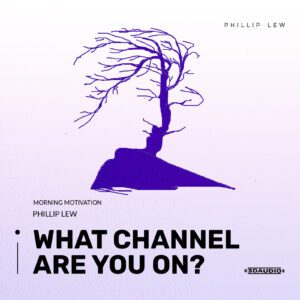


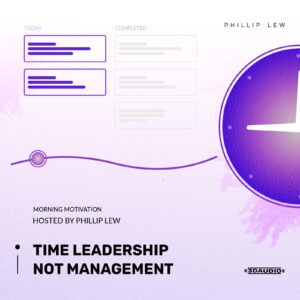




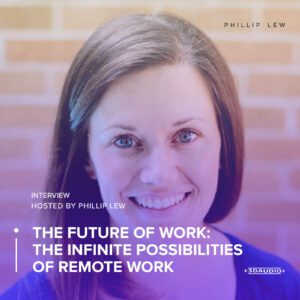
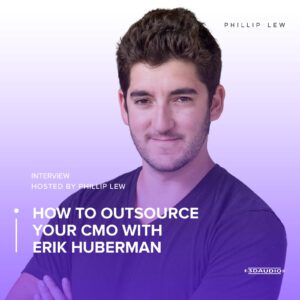

0 Comments